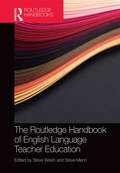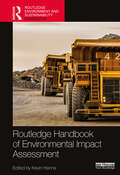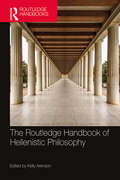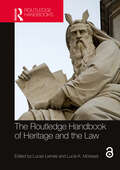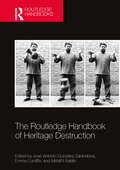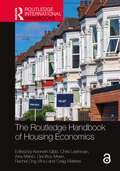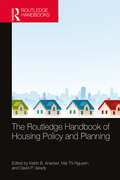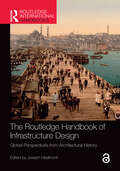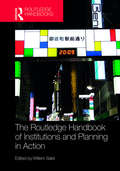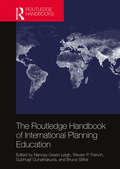- Table View
- List View
The Routledge Handbook of English Language Teacher Education (Routledge Handbooks in Applied Linguistics)
by Steve Walsh; Steve MannThe Routledge Handbook of English Language Teacher Education provides an accessible, authoritative, comprehensive and up-to-date resource of English language teacher education. With an overview of historical issues, theoretical frameworks and current debates, this handbook provides unique insights into a range of teacher education contexts, focusing on key issues relating to teacher and learner priorities, language and communication, current practices, reflective practice, and research. Key features include: a cross-section of current theories, practices and issues, providing readers with a resource which can be used in a variety of contexts; the use of data, transcripts and tasks to highlight and illustrate a range of practices, including examples of ‘best practice’; ‘snapshots’ of ELTE from a number of contexts taken from all around the world; and examples of current technological advances, contemporary thinking on reflective practice, and insights gained from recent research. This wide-ranging and international collection of chapters has been written by leading experts in the field. The Routledge Handbook of English Language Teacher Education is sure to be core reading for students, researchers and educators in applied linguistics, TESOL and language education.
The Routledge Handbook of English Language Teacher Education (Routledge Handbooks in Applied Linguistics)
by Steve Walsh Steve MannThe Routledge Handbook of English Language Teacher Education provides an accessible, authoritative, comprehensive and up-to-date resource of English language teacher education. With an overview of historical issues, theoretical frameworks and current debates, this handbook provides unique insights into a range of teacher education contexts, focusing on key issues relating to teacher and learner priorities, language and communication, current practices, reflective practice, and research. Key features include: a cross-section of current theories, practices and issues, providing readers with a resource which can be used in a variety of contexts; the use of data, transcripts and tasks to highlight and illustrate a range of practices, including examples of ‘best practice’; ‘snapshots’ of ELTE from a number of contexts taken from all around the world; and examples of current technological advances, contemporary thinking on reflective practice, and insights gained from recent research. This wide-ranging and international collection of chapters has been written by leading experts in the field. The Routledge Handbook of English Language Teacher Education is sure to be core reading for students, researchers and educators in applied linguistics, TESOL and language education.
Routledge Handbook of Environmental Impact Assessment (Routledge Environment and Sustainability Handbooks)
by Kevin HannaGlobally, environmental impact assessment (EIA) is one of the most enduring and influential environmental management tools. This handbook provides readers with a strong foundation for understanding the practice of EIA, by outlining the different types of assessment while also providing a guide to best practice. This collection deploys a research and practice-based approach to the subject, delivering an overview of EIA as an essential and practical tool of environmental protection, planning, and policy. To best understand the most pertinent issues and challenges surrounding EIA today, this volume draws together prominent researchers, practitioners, and young scholars who share their work and knowledge to cover two key parts. The first part introduces EIA processes and best practices through analytical and critical chapters on the stages/elements of the EIA process and different components and forms of assessment. These provide examples that cover a wide range of assessment methods and cross-cutting issues, including cumulative effects assessment, social impact assessment, Indigenous-led assessment, risk assessment, climate change, and gender-based assessment. The second part provides jurisdictional reviews of the European Union, the US National Environmental Policy Act, recent assessment reforms in Canada, EIA in developing economies, and the EIA context in England. By providing a concise outline of the process followed by in-depth illustrations of approaches, methods and tools, and case studies, this book will be essential for students, scholars, and practitioners of environmental impact assessment.
Routledge Handbook of Environmental Impact Assessment (Routledge Environment and Sustainability Handbooks)
by Kevin HannaGlobally, environmental impact assessment (EIA) is one of the most enduring and influential environmental management tools. This handbook provides readers with a strong foundation for understanding the practice of EIA, by outlining the different types of assessment while also providing a guide to best practice. This collection deploys a research and practice-based approach to the subject, delivering an overview of EIA as an essential and practical tool of environmental protection, planning, and policy. To best understand the most pertinent issues and challenges surrounding EIA today, this volume draws together prominent researchers, practitioners, and young scholars who share their work and knowledge to cover two key parts. The first part introduces EIA processes and best practices through analytical and critical chapters on the stages/elements of the EIA process and different components and forms of assessment. These provide examples that cover a wide range of assessment methods and cross-cutting issues, including cumulative effects assessment, social impact assessment, Indigenous-led assessment, risk assessment, climate change, and gender-based assessment. The second part provides jurisdictional reviews of the European Union, the US National Environmental Policy Act, recent assessment reforms in Canada, EIA in developing economies, and the EIA context in England. By providing a concise outline of the process followed by in-depth illustrations of approaches, methods and tools, and case studies, this book will be essential for students, scholars, and practitioners of environmental impact assessment.
Routledge Handbook of Health and Media
by Lester D. Friedman Therese JonesThe Routledge Handbook of Health and Media provides an extensive review and exploration of the myriad ways that health and media function as a symbiotic partnership that profoundly influences contemporary societies. A unique and significant volume in an expanding pedagogical field, this diverse collection of international, original, and interdisciplinary essays goes beyond issues of representation to engage in scholarly conversations about the web of networks that inextricably bind media and health to each other. Divided into sections on film, television, animation, photography, comics, advertising, social media, and print journalism, each chapter begins with a concrete text or texts, using it to raise more general and more theoretical issues about the medium in question. As such, this Handbook defines, expands, and illuminates the role that the humanities and arts play in the education and practice of healthcare professionals and in our understanding of health, illness, and disability. The Routledge Handbook of Health and Media is an invaluable reference for academics, students and health professionals engaged with cultural issues in media and medicine, popular representations of disease and disability, and the patient/professional health care encounter.
Routledge Handbook of Health and Media
by Lester D. Friedman Therese JonesThe Routledge Handbook of Health and Media provides an extensive review and exploration of the myriad ways that health and media function as a symbiotic partnership that profoundly influences contemporary societies. A unique and significant volume in an expanding pedagogical field, this diverse collection of international, original, and interdisciplinary essays goes beyond issues of representation to engage in scholarly conversations about the web of networks that inextricably bind media and health to each other. Divided into sections on film, television, animation, photography, comics, advertising, social media, and print journalism, each chapter begins with a concrete text or texts, using it to raise more general and more theoretical issues about the medium in question. As such, this Handbook defines, expands, and illuminates the role that the humanities and arts play in the education and practice of healthcare professionals and in our understanding of health, illness, and disability. The Routledge Handbook of Health and Media is an invaluable reference for academics, students and health professionals engaged with cultural issues in media and medicine, popular representations of disease and disability, and the patient/professional health care encounter.
The Routledge Handbook of Hellenistic Philosophy (Routledge Handbooks in Philosophy)
by Kelly ArensonHellenistic philosophy concerns the thought of the Epicureans, Stoics, and Skeptics, the most influential philosophical groups in the era between the death of Alexander the Great (323 BCE) and the defeat of the last Greek stronghold in the ancient world (31 BCE). The Routledge Handbook of Hellenistic Philosophy provides accessible yet rigorous introductions to the theories of knowledge, ethics, and physics belonging to each of the three schools, explores the fascinating ways in which interschool rivalries shaped the philosophies of the era, and offers unique insight into the relevance of Hellenistic views to issues today, such as environmental ethics, consumerism, and bioethics. Eleven countries are represented among the Handbook’s 35 authors, whose chapters were written specifically for this volume and are organized thematically into six sections: The people, history, and methods of Epicureanism, Stoicism, and Skepticism. Earlier philosophical influences on Hellenistic thought, such as Aristotle, Socrates, and Presocratics. The soul, perception, and knowledge. God, fate, and the primary principles of nature and the universe. Ethics, political theory, society, and community. Hellenistic philosophy’s relevance to contemporary life. Spanning from the ancient past to the present, this Handbook aims to show that Hellenistic philosophy has much to offer all thinking people of the twenty-first century.
The Routledge Handbook of Hellenistic Philosophy (Routledge Handbooks in Philosophy)
by Kelly ArensonHellenistic philosophy concerns the thought of the Epicureans, Stoics, and Skeptics, the most influential philosophical groups in the era between the death of Alexander the Great (323 BCE) and the defeat of the last Greek stronghold in the ancient world (31 BCE). The Routledge Handbook of Hellenistic Philosophy provides accessible yet rigorous introductions to the theories of knowledge, ethics, and physics belonging to each of the three schools, explores the fascinating ways in which interschool rivalries shaped the philosophies of the era, and offers unique insight into the relevance of Hellenistic views to issues today, such as environmental ethics, consumerism, and bioethics. Eleven countries are represented among the Handbook’s 35 authors, whose chapters were written specifically for this volume and are organized thematically into six sections: The people, history, and methods of Epicureanism, Stoicism, and Skepticism. Earlier philosophical influences on Hellenistic thought, such as Aristotle, Socrates, and Presocratics. The soul, perception, and knowledge. God, fate, and the primary principles of nature and the universe. Ethics, political theory, society, and community. Hellenistic philosophy’s relevance to contemporary life. Spanning from the ancient past to the present, this Handbook aims to show that Hellenistic philosophy has much to offer all thinking people of the twenty-first century.
The Routledge Handbook of Heritage and the Law (Routledge Handbooks on Museums, Galleries and Heritage)
by Lucas Lixinski Lucie K. MorissetThe Routledge Handbook of Heritage and the Law sheds light on the relationship between the two fields and analyses how the law shapes heritage and heritage practice in both expected and unexpected ways.Including contributions from 41 authors working across a range of jurisdictions, the volume analyses the law as a transnational phenomenon and uses international and comparative legal methodologies to distil lessons for broad application. Demonstrating that the law is fundamentally a language of power and contestation, the Handbook shows how this impacts our views of heritage. It also shows that, to understand the ways in which the law impacts key aspects of heritage practice, it is important to tap into the possibilities of heritage as points of convergence of identity, struggles over resources, and the distribution of power. Framing heritage as a driver for legal engagement rather than a passive regulatory object, the book first reviews the legal fields or mechanisms that can shape action in the heritage field, then questions how these enable authority and give power to those who seize heritage, and finally envisions how the discussion between heritage and the law can lay new grounds in both those fields. Lifting the mists that often render the law opaque in heritage studies, the Handbook showcases the law as a medium through which the culture and the power of heritage are expressed and might be shared.The Routledge Handbook of Heritage and the Law presents a view of the law that is aimed at those who wish to reflect on how law has changed, or could change, what heritage is and how it can support social, cultural, local, or other development. It will be of interest to scholars, students, policymakers, and practitioners working in the areas of museum studies, heritage studies, and urban studies, as well as in cultural intervention and planning.Chapter 8 of this book is freely available as a downloadable Open Access PDF at http://www.taylorfrancis.com under a Creative Commons [Attribution-Non Commercial-No Derivatives (CC-BY-NC-ND)] 4.0 license.Chapter 34 of this book is freely available as a downloadable Open Access PDF at http://www.taylorfrancis.com under a Creative Commons (CC-BY) 4.0 license.The Routledge Handbook of Heritage and the Law | Lucas Lixinski, Lucie (taylorfrancis.com)
The Routledge Handbook of Heritage and the Law (Routledge Handbooks on Museums, Galleries and Heritage)
The Routledge Handbook of Heritage and the Law sheds light on the relationship between the two fields and analyses how the law shapes heritage and heritage practice in both expected and unexpected ways.Including contributions from 41 authors working across a range of jurisdictions, the volume analyses the law as a transnational phenomenon and uses international and comparative legal methodologies to distil lessons for broad application. Demonstrating that the law is fundamentally a language of power and contestation, the Handbook shows how this impacts our views of heritage. It also shows that, to understand the ways in which the law impacts key aspects of heritage practice, it is important to tap into the possibilities of heritage as points of convergence of identity, struggles over resources, and the distribution of power. Framing heritage as a driver for legal engagement rather than a passive regulatory object, the book first reviews the legal fields or mechanisms that can shape action in the heritage field, then questions how these enable authority and give power to those who seize heritage, and finally envisions how the discussion between heritage and the law can lay new grounds in both those fields. Lifting the mists that often render the law opaque in heritage studies, the Handbook showcases the law as a medium through which the culture and the power of heritage are expressed and might be shared.The Routledge Handbook of Heritage and the Law presents a view of the law that is aimed at those who wish to reflect on how law has changed, or could change, what heritage is and how it can support social, cultural, local, or other development. It will be of interest to scholars, students, policymakers, and practitioners working in the areas of museum studies, heritage studies, and urban studies, as well as in cultural intervention and planning.Chapter 8 of this book is freely available as a downloadable Open Access PDF at http://www.taylorfrancis.com under a Creative Commons [Attribution-Non Commercial-No Derivatives (CC-BY-NC-ND)] 4.0 license.Chapter 34 of this book is freely available as a downloadable Open Access PDF at http://www.taylorfrancis.com under a Creative Commons (CC-BY) 4.0 license.The Routledge Handbook of Heritage and the Law | Lucas Lixinski, Lucie (taylorfrancis.com)
The Routledge Handbook of Heritage Destruction (Routledge Handbooks on Museums, Galleries and Heritage)
by José Antonio González Zarandona Emma Cunliffe Melathi SaldinThe Routledge Handbook of Heritage Destruction presents a comprehensive view on the destruction of cultural heritage and offers insights into this multifaceted, interdisciplinary phenomenon; the methods scholars have used to study it; and the results these various methods have produced. By juxtaposing theoretical and legal frameworks and conceptual contexts alongside a wide distribution of geographical and temporal case studies, this book throws light upon the risks, and the realizations, of art and heritage destruction. Exploring the variety of forces that drive the destruction of heritage, the volume also contains contributions that consider what forms heritage destruction takes and in which contexts and circumstances it manifests. Contributors, including local scholars, also consider how these drivers and contexts change, and what effect this has on heritage destruction, and how we conceptualise it. Overall, the book establishes the importance of the need to study the destruction of art and cultural heritage within a wider framework that encompasses not only theory but also legal, military, social, and ontological issues. The Routledge Handbook of Heritage Destruction will contribute to the development of a more complete understanding and analysis of heritage destruction. The Handbook will be useful to academics, students, and professionals with interest in heritage, conservation and preservation, history and art history, archaeology, anthropology, philosophy, and law.
The Routledge Handbook of Heritage Destruction (Routledge Handbooks on Museums, Galleries and Heritage)
by Zarandona, José Antonio González Emma Cunliffe Melathi SaldinThe Routledge Handbook of Heritage Destruction presents a comprehensive view on the destruction of cultural heritage and offers insights into this multifaceted, interdisciplinary phenomenon; the methods scholars have used to study it; and the results these various methods have produced. By juxtaposing theoretical and legal frameworks and conceptual contexts alongside a wide distribution of geographical and temporal case studies, this book throws light upon the risks, and the realizations, of art and heritage destruction. Exploring the variety of forces that drive the destruction of heritage, the volume also contains contributions that consider what forms heritage destruction takes and in which contexts and circumstances it manifests. Contributors, including local scholars, also consider how these drivers and contexts change, and what effect this has on heritage destruction, and how we conceptualise it. Overall, the book establishes the importance of the need to study the destruction of art and cultural heritage within a wider framework that encompasses not only theory but also legal, military, social, and ontological issues. The Routledge Handbook of Heritage Destruction will contribute to the development of a more complete understanding and analysis of heritage destruction. The Handbook will be useful to academics, students, and professionals with interest in heritage, conservation and preservation, history and art history, archaeology, anthropology, philosophy, and law.
Routledge Handbook of High-Performance Workplaces (Transdisciplinary Workplace Research and Management)
by Christhina Candido Iva Durakovic Samin MarzbanThis timely book focuses on an overview of the fundamentals behind high-performance workplaces underpinning occupants’ satisfaction, health, and productivity. To this end, it covers human, environmental, and organisational aspects proven to be of great relevance to the design of high-performance workplaces. Perhaps most significantly it looks at these characteristics both before and after the start of the COVID-19 pandemic. From the exodus from private offices to the rise of open-plan workplaces, where, how and when people work was changing rapidly pre-COVID. Post-COVID, pandemic-imposed restrictions banished workers from offices into their homes fast, leaving organisation scrambling to keep workers functioning away from HQ. After the immediate shockwaves set by the pandemic, workers and organisations have had the time to learn about positives and negative aspects of remote working with the vast majority now questioning the need to go back to HQ and the purpose of offices. In this book, the contributors share and discuss lessons learned from research conducted in workplaces pre- and post-2020 with a view of providing a clear picture about what high-performance workplaces are about, including the key drivers behind workers’ satisfaction, health, and productivity. This handbook builds on a programme of applied research conducted in workplaces led by the editors over the last decade which is aimed at understanding the synergies between the design, performance, and experience of spaces. It examines ergonomics, biophilic design, acoustics, indoor air quality, thermal comfort, diversity, leadership, psychological safety, culture, and much more. Research findings are presented side-by-side with case studies selected from the research database led by the editors. Industry experts add to the academic voice, reinforcing the authenticity of this book and its relevance to other stakeholders found outside the academic arena, including the property and design industry, students, government, and the community in general.The Open Access version of this book, available at http://www.taylorfrancis.com, has been made available under a Creative Commons Attribution-Non Commercial-No Derivatives (CC-BY-NC-ND) 4.0 license.
Routledge Handbook of High-Performance Workplaces (Transdisciplinary Workplace Research and Management)
This timely book focuses on an overview of the fundamentals behind high-performance workplaces underpinning occupants’ satisfaction, health, and productivity. To this end, it covers human, environmental, and organisational aspects proven to be of great relevance to the design of high-performance workplaces. Perhaps most significantly it looks at these characteristics both before and after the start of the COVID-19 pandemic. From the exodus from private offices to the rise of open-plan workplaces, where, how and when people work was changing rapidly pre-COVID. Post-COVID, pandemic-imposed restrictions banished workers from offices into their homes fast, leaving organisation scrambling to keep workers functioning away from HQ. After the immediate shockwaves set by the pandemic, workers and organisations have had the time to learn about positives and negative aspects of remote working with the vast majority now questioning the need to go back to HQ and the purpose of offices. In this book, the contributors share and discuss lessons learned from research conducted in workplaces pre- and post-2020 with a view of providing a clear picture about what high-performance workplaces are about, including the key drivers behind workers’ satisfaction, health, and productivity. This handbook builds on a programme of applied research conducted in workplaces led by the editors over the last decade which is aimed at understanding the synergies between the design, performance, and experience of spaces. It examines ergonomics, biophilic design, acoustics, indoor air quality, thermal comfort, diversity, leadership, psychological safety, culture, and much more. Research findings are presented side-by-side with case studies selected from the research database led by the editors. Industry experts add to the academic voice, reinforcing the authenticity of this book and its relevance to other stakeholders found outside the academic arena, including the property and design industry, students, government, and the community in general.The Open Access version of this book, available at http://www.taylorfrancis.com, has been made available under a Creative Commons Attribution-Non Commercial-No Derivatives (CC-BY-NC-ND) 4.0 license.
The Routledge Handbook of Housing Economics (Routledge International Handbooks)
by Kenneth Gibb Chris Leishman Alex Marsh Geoffrey Meen Rachel Ong ViforJ Craig WatkinsThe Routledge Handbook of Housing Economics brings together an international panel of contributors to present a comprehensive overview of this important field within economics. Housing occupies an increasingly central role in modern society, dominating consumer assets and spending, forming an important part of social policy and being a large enough market to impact the macroeconomy. This handbook tackles these themes, along with other critical issues such as intergenerational housing inequality and the efficiency and social justice of housing interventions.This volume is structured in four main parts. It starts with eight chapters in microeconomics and housing. This is followed by two shorter sections on macroeconomics and finance. The final main part of the book is concerned with eight chapters on policy dimensions. While many of the chapters are rooted in mainstream economics and finance applied to housing, there are also chapters stressing institutional, behavioural and political economy orientations, as well as those that explicitly challenge more mainstream accounts. The contributing authors are based in Europe, North America and Australia and all draw in international literature to provide state of the art reviews of their topics.This carefully curated handbook will be essential reading for advanced students, researchers and policy makers in housing economics, urban economics, urban planning, public economics and real estate economics and finance.
The Routledge Handbook of Housing Economics (Routledge International Handbooks)
The Routledge Handbook of Housing Economics brings together an international panel of contributors to present a comprehensive overview of this important field within economics. Housing occupies an increasingly central role in modern society, dominating consumer assets and spending, forming an important part of social policy and being a large enough market to impact the macroeconomy. This handbook tackles these themes, along with other critical issues such as intergenerational housing inequality and the efficiency and social justice of housing interventions.This volume is structured in four main parts. It starts with eight chapters in microeconomics and housing. This is followed by two shorter sections on macroeconomics and finance. The final main part of the book is concerned with eight chapters on policy dimensions. While many of the chapters are rooted in mainstream economics and finance applied to housing, there are also chapters stressing institutional, behavioural and political economy orientations, as well as those that explicitly challenge more mainstream accounts. The contributing authors are based in Europe, North America and Australia and all draw in international literature to provide state of the art reviews of their topics.This carefully curated handbook will be essential reading for advanced students, researchers and policy makers in housing economics, urban economics, urban planning, public economics and real estate economics and finance.
The Routledge Handbook of Housing Policy and Planning
by Katrin B. Anacker Mai Thi Nguyen David P. VaradyThe Routledge Handbook of Housing Policy and Planning provides a comprehensive multidisciplinary overview of contemporary trends in housing studies, housing policies, planning for housing, and housing innovations in the United States, the United Kingdom, and Continental Europe. In 29 chapters, international scholars discuss aspects pertaining to the right to housing, inequality, homeownership, rental housing, social housing, senior housing, gentrification, cities and suburbs, and the future of housing policies. This book is essential reading for students, policy analysts, policymakers, practitioners, and activists, as well as others interested in housing policy and planning.
The Routledge Handbook of Housing Policy and Planning
by Katrin B. Anacker Mai Thi Nguyen David P. VaradyThe Routledge Handbook of Housing Policy and Planning provides a comprehensive multidisciplinary overview of contemporary trends in housing studies, housing policies, planning for housing, and housing innovations in the United States, the United Kingdom, and Continental Europe. In 29 chapters, international scholars discuss aspects pertaining to the right to housing, inequality, homeownership, rental housing, social housing, senior housing, gentrification, cities and suburbs, and the future of housing policies. This book is essential reading for students, policy analysts, policymakers, practitioners, and activists, as well as others interested in housing policy and planning.
The Routledge Handbook of Infrastructure Design: Global Perspectives from Architectural History
by Joseph HeathcottThe Routledge Handbook of Infrastructure Design explores the multifaceted nature of infrastructure through the global lens of architectural history. Infrastructure holds the world together. Yet even as it connects some people, it divides others, sorting access and connectivity through varied social categories such as class, race, gender, and citizenship. This collection examines themes across broad spans of time, raises questions of linkage and scale, investigates infrastructure as phenomenon and affect, and traces the interrelation of aesthetics, technology, and power. With a diverse range of contributions from 33 scholars, this volume presents new research from regions including South and East Asia, Sub-Saharan Africa, South America, North America, Western Europe, the Middle East, and the former Soviet Union. This extraordinary group of authors bring close attention to the materials, functions, and aesthetics of infrastructure systems as these unfold within their cultural and political contexts. They provide not only new knowledge of specific artifacts, such as the Valens Aqueduct, the Hong Kong waterfront, and the Pan-American Highway, but also new ways of conceptualizing, studying, and understanding infrastructure as a worlding process. The Routledge Handbook of Infrastructure Design provides richly textured, thoroughly evidenced, and imaginatively drawn arguments that deepen our understanding of the role of infrastructure in creating the world in which we live. It is a must-read for academics and students.
The Routledge Handbook of Infrastructure Design: Global Perspectives from Architectural History
by Joseph HeathcottThe Routledge Handbook of Infrastructure Design explores the multifaceted nature of infrastructure through the global lens of architectural history. Infrastructure holds the world together. Yet even as it connects some people, it divides others, sorting access and connectivity through varied social categories such as class, race, gender, and citizenship. This collection examines themes across broad spans of time, raises questions of linkage and scale, investigates infrastructure as phenomenon and affect, and traces the interrelation of aesthetics, technology, and power. With a diverse range of contributions from 33 scholars, this volume presents new research from regions including South and East Asia, Sub-Saharan Africa, South America, North America, Western Europe, the Middle East, and the former Soviet Union. This extraordinary group of authors bring close attention to the materials, functions, and aesthetics of infrastructure systems as these unfold within their cultural and political contexts. They provide not only new knowledge of specific artifacts, such as the Valens Aqueduct, the Hong Kong waterfront, and the Pan-American Highway, but also new ways of conceptualizing, studying, and understanding infrastructure as a worlding process. The Routledge Handbook of Infrastructure Design provides richly textured, thoroughly evidenced, and imaginatively drawn arguments that deepen our understanding of the role of infrastructure in creating the world in which we live. It is a must-read for academics and students.
The Routledge Handbook of Institutions and Planning in Action
by Willem SaletThe Routledge Handbook of Institutions and Planning in Action contains a selection of 25 chapters prepared by specialized international scholars of urban planning and urban studies focusing on the question of how institutional innovation occurs in practices of action. The contributors share expertise on institutional innovation and philosophical pragmatism. They discuss the different facets of these two conceptual frameworks and explore the alternative combinations through which they can be approached. The relevance of these conceptual lines of thought will be exemplified in exploring the contemporary practices of sustainable (climate-proof) urban transition. The aim of the handbook is to give a boost to the turn of institutional analysis in the context of action in changing cities. Both philosophical pragmatism and institutional innovation rest on wide international uses in social sciences and planning studies, and may be considered as complementary for many reasons. However, the combination of these different approaches is all but evident and creates a number of dilemmas. After an encompassing introductory section entitled Institutions in Action, the handbook is further divided into the following sections: Institutional innovation Pragmatism: The Dimension of Action On Justification Cultural and Political Institutions in Action Institutions and Urban Transition
The Routledge Handbook of Institutions and Planning in Action
by Willem SaletThe Routledge Handbook of Institutions and Planning in Action contains a selection of 25 chapters prepared by specialized international scholars of urban planning and urban studies focusing on the question of how institutional innovation occurs in practices of action. The contributors share expertise on institutional innovation and philosophical pragmatism. They discuss the different facets of these two conceptual frameworks and explore the alternative combinations through which they can be approached. The relevance of these conceptual lines of thought will be exemplified in exploring the contemporary practices of sustainable (climate-proof) urban transition. The aim of the handbook is to give a boost to the turn of institutional analysis in the context of action in changing cities. Both philosophical pragmatism and institutional innovation rest on wide international uses in social sciences and planning studies, and may be considered as complementary for many reasons. However, the combination of these different approaches is all but evident and creates a number of dilemmas. After an encompassing introductory section entitled Institutions in Action, the handbook is further divided into the following sections: Institutional innovation Pragmatism: The Dimension of Action On Justification Cultural and Political Institutions in Action Institutions and Urban Transition
Routledge Handbook of Integrated Project Delivery
by Derek Walker Steve RowlinsonThe concept of integrated project delivery (IPD) has evolved as a result of the need for highly expert teams of people to collaborate to deliver extremely complex projects, to manage expectations about delivery speed, changes in governance standards and to take advantage of and manage expectations raised by rapid advances in technology. All this demands effective change management. This is the first Handbook to contextualise and thematically explore the concept with an emphasis on rigorous practical and theoretical validation. The Handbook is divided into five sections, each with a focus on several interconnected themes including: An introduction to IPD concepts. The foundational elements and characteristics of IPD. People, culture and collaboration as key ingredients to successful and effective IPD. Technology and process aspects of relational contracting forms such as IPD. New and relevant perspectives to IPD that have received scant attention to date. Aspects and emerging issues that are rarely consciously considered in traditional project delivery due to the commercial imperative that drives firms and client organisations. The Handbook offers both discussions of these key themes, and also in-depth research into construction and other industry project procurement and delivery that spans decades. In addition, the Handbook presents ‘best’ and ‘better’ practice, but also includes insights into cutting-edge experimental developments in technology and practices where proof of concept is currently being developed into emerging practice. Contributing authors in this Handbook collaborate with the co-editors to draw together an integrated set of chapters that align to deliver a coherent narrative of the IPD concept. It is an invaluable reference for practitioners and academics alike, and useful as core course content for numerous degree programs of study and professional development courses.
Routledge Handbook of Integrated Project Delivery
by Derek Walker Steve RowlinsonThe concept of integrated project delivery (IPD) has evolved as a result of the need for highly expert teams of people to collaborate to deliver extremely complex projects, to manage expectations about delivery speed, changes in governance standards and to take advantage of and manage expectations raised by rapid advances in technology. All this demands effective change management. This is the first Handbook to contextualise and thematically explore the concept with an emphasis on rigorous practical and theoretical validation. The Handbook is divided into five sections, each with a focus on several interconnected themes including: An introduction to IPD concepts. The foundational elements and characteristics of IPD. People, culture and collaboration as key ingredients to successful and effective IPD. Technology and process aspects of relational contracting forms such as IPD. New and relevant perspectives to IPD that have received scant attention to date. Aspects and emerging issues that are rarely consciously considered in traditional project delivery due to the commercial imperative that drives firms and client organisations. The Handbook offers both discussions of these key themes, and also in-depth research into construction and other industry project procurement and delivery that spans decades. In addition, the Handbook presents ‘best’ and ‘better’ practice, but also includes insights into cutting-edge experimental developments in technology and practices where proof of concept is currently being developed into emerging practice. Contributing authors in this Handbook collaborate with the co-editors to draw together an integrated set of chapters that align to deliver a coherent narrative of the IPD concept. It is an invaluable reference for practitioners and academics alike, and useful as core course content for numerous degree programs of study and professional development courses.
The Routledge Handbook of International Planning Education
by Nancey Green Leigh Steven P. French Subhrajit Guhathakurta Bruce StiftelThe Routledge Handbook of International Planning Education is the first comprehensive handbook with a unique focus on planning education. Comparing approaches to the delivery of planning education by three major planning education accreditation bodies in the United States, Australia, and the United Kingdom, and reflecting concerns from other national planning systems, this handbook will help to meet the strong interest and need for understanding how planning education is developed and delivered in different international contexts. The handbook is divided into five major sections, including coverage of general planning knowledge, planning skills, traditional and emerging planning specializations, and pedagogy. An international cohort of contributors covers each subject’s role in educating planners, its theory and methods, key literature contributions, and course design. Higher education’s response to globalization has included growth in planning educational exchanges across international boundaries; The Routledge Handbook of International Planning Education is an essential resource for planners and planning educators, informing the dialogue on the mobility of planners educated under different national schema.
